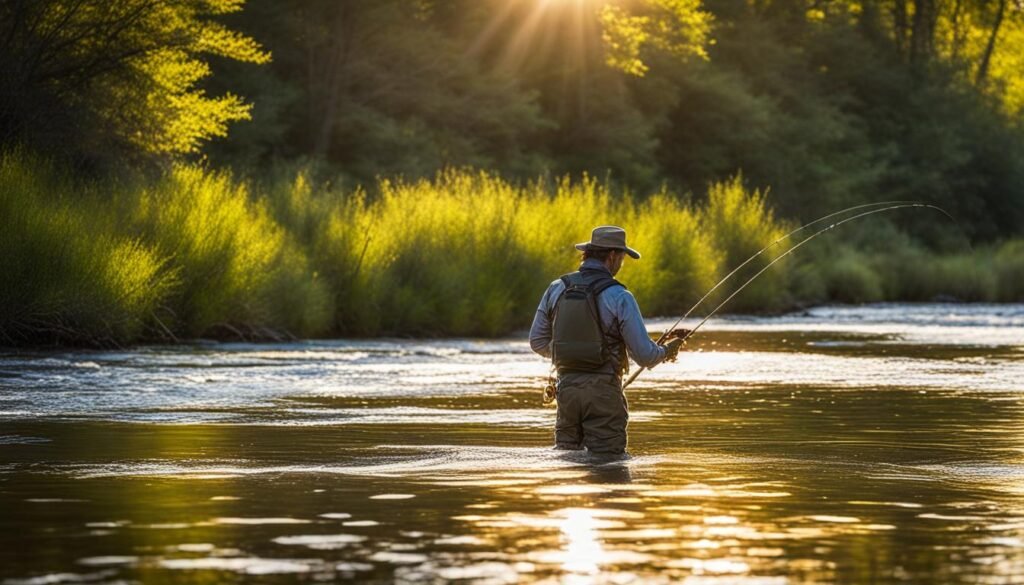If you want to improve your fly presentations and achieve a natural dead drift, mastering fly line mending is essential. Mending allows for longer drifts and reduces drag, making your fly look irresistible to fish. Whether you’re fishing with dry flies, nymphs, or streamers, these techniques will take your fly fishing game to the next level.
- Fly fishing mending techniques are crucial for successful fly presentations and achieving a natural dead drift.
- Mending the fly line allows for longer drifts and reduces drag, making your fly appear more natural to the fish.
- There are various mending techniques such as the upstream mend, double mend, and reach cast, each suited for different water conditions.
- Five tips for effective fly line mending include starting with some slack, using swift movements, mending the leader, greasing the line, and mending soon after the cast.
- Mastering these techniques will improve your chances of success in fly fishing and make your fly look irresistible to fish.
Why is fly line mending necessary?
Fly line mending is an essential technique in fly fishing that allows you to extend the drift of your fly and reduce drag, resulting in a more natural presentation. When you mend the fly line, you adjust its position on the water, counteracting the effects of the current and making it appear as if the fly is floating naturally with the flow.
Mending becomes particularly important when fishing in different water speeds, where various currents meet. These areas, known as hinging points, can disrupt the drift of your fly if not properly addressed. By executing precise mending techniques, you can create hinging points on the seams of these currents, allowing your fly to drift longer and more naturally.
Upstream Mend
The upstream mend is a valuable fly fishing mending technique that allows you to extend the drift of your fly in fast-moving water. By throwing the line upstream, you delay the moment when the line starts pulling the fly downstream, giving you more time to present your fly to the fish. It’s a skill that every fly angler should have in their arsenal, especially when targeting fish in rivers and streams with varying water speeds.
To execute the upstream mend effectively, you need to focus on creating a hinge point right on the seam between the fast water and slow water. This is where the line will pivot, allowing your fly to continue drifting naturally. Cast across the fast water and use a swift movement to throw the line upstream, aiming for the desired hinge point. As the fly drifts downstream, lift the rod tip while simultaneously pulling in the line to maintain tension and control.
If you’re facing upstream, another technique is to cast upstream and then lift the rod tip while pulling in line as the fly approaches. This upstream mend technique is particularly useful when fishing with dry flies or nymphs in fast water, allowing you to create a drag-free drift and increase your chances of enticing a strike from the fish.
Tips for Successful Upstream Mending:
- Focus on creating a hinge point on the seam between fast water and slow water.
- Make a swift movement to throw the line upstream, aiming for the desired hinge point.
- Lift the rod tip while simultaneously pulling in the line as the fly drifts downstream to maintain tension and control.
- Experiment with different casting angles and approaches to find what works best in specific fishing situations.
- Practice and refine your upstream mend technique to become more proficient in extending the drift of your fly in fast water.
Double Mend: Mastering Advanced Mending Techniques

When it comes to fly fishing, mending the fly line is a crucial skill for navigating fast water and fishing across eddies. The double mend technique is an advanced mending technique that allows anglers to extend the fly’s drift and maintain control in challenging conditions. By executing a succession of upstream and downstream mends, you can create hinging points on the seams of different currents, ensuring your fly behaves naturally.
Why Use the Double Mend?
The double mend technique is essential when fishing across eddies and fast water. It enables you to overcome the conflicting currents and varying speeds that can interrupt your fly’s natural drift. By combining an upstream and downstream mend, you gain greater control over the fly line, reducing drag and improving your chances of enticing fish in these challenging fishing conditions.
Mastering the Double Mend
To execute the double mend effectively, start with an upstream mend. By throwing the line upstream, you delay the point at which the line begins to pull the fly downstream, extending the drift. As the fly approaches the hinging point, follow up with a downstream mend to maintain control. Adjust the rod tip height and the amount of line picked up off the water to control the hinge point and ensure a drag-free drift across complex currents.
- Start with an upstream mend to extend the drift.
- Follow up with a downstream mend to maintain control.
- Adjust rod tip height and line pickup to control the hinge point.
Reach Cast
When fishing in calmer waters with less variation in current speed and direction, the reach cast is a valuable technique to achieve a drag-free drift. By throwing a mend into the line before the fly hits the water, you can create slack and ensure that your fly drifts naturally. This technique is particularly effective when fishing dry flies in moving water.
Advantages of the Reach Cast:
- Creates slack in the line, minimizing drag for a natural presentation
- Allows for a longer drift, increasing the chances of enticing a strike
- Works well in calmer waters with minimal current variations
To execute a reach cast, follow these steps:
- Begin with a standard casting motion, aiming for your target area in the calmer water.
- As your fly line extends, make a slight upstream or lateral movement with your rod hand, throwing a mend into the line.
- This mend will create slack and enable your fly to drift freely without being affected by drag.
Five Tips for Effective Fly Line Mending
To improve your fly line mending skills, here are five tips to keep in mind:
1. Start with Slack
Always land your cast with some slack to start with. This provides a better foundation for mending and allows you to easily reposition the line. Starting with slack gives you more control over the drift and helps achieve a drag-free presentation.
2. Swift and Crisp Movements
Use swift and crisp movements when mending the line. This generates enough speed and force to effectively reposition the fly line and the leader. By being decisive with your mends, you can quickly adjust the line’s position and reduce any unwanted drag.
3. Mend the Leader
Don’t forget to mend the leader as well. The leader plays a significant role in reducing drag, so it’s crucial to ensure it remains in the desired position. By mending both the fly line and the leader, you can achieve a more natural presentation and increase your chances of enticing a strike.
4. Grease It
Consider using a little grease on your fly line and leader. By applying a small amount of floatant, you improve their floatation and make it easier to mend. This extra buoyancy allows for smoother mending and helps maintain a drag-free drift in various water conditions.
5. Mend Soon and Often
Mend as soon as the cast finishes and continue to mend throughout the drift. By mending early and frequently, you counteract the effects of suction and keep the fly line and leader in the desired position. This ensures a more natural presentation and maximizes your chances of success.

